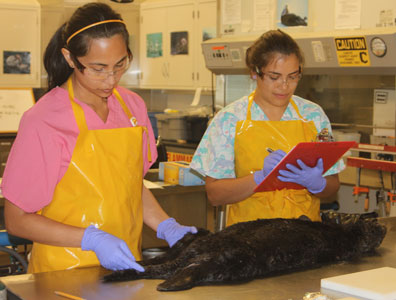 The examination of a sea otter by CDFW lab technicians during necropsy
The examination of a sea otter by CDFW lab technicians during necropsy
A primary focus of the MWVCRC is providing pathology and laboratory diagnostic investigation services for sea otter mortalities and other marine wildlife mortality events, and archiving of tissues and specimens. This research provides information to OSPR, CDFW, and other agencies on factors limiting the recovery of the southern sea otter population, and information on background mortality rates of otters and other marine wildlife (useful for detecting unusual mortality events). The 2003 USFWS Recovery Plan for the southern sea otter identifies the CDFW as the lead agency for investigation of mortality.
Today, the majority of all Southern sea otters found dead off the coast of California are brought to the MWVCRC in Santa Cruz for necropsy or are examined in the field by CDFW sea otter biologists. The MWVCRC has a dedicated necropsy laboratory for post-mortem examinations of sea otters and other marine wildlife. For more information on what we’ve learned by investigating sea otter pathology, see our Technical Reports and Publications pages. This work is supported in part by the California Sea Otter Voluntary Tax Contribution Fund, found on line 410 of California state income tax forms.
Causes of Mortality in Southern Sea Otters
In 2020, we published a paper summarizing information on causes of death for 560 southern sea otters recovered and necropsied over a 15-year period from 1998 to 2012.Although these animals represent a small fraction of the total number of sea otters that die in California each year, this mortality information provides an approximation of the range and relative proportion of factors responsible for sea otter mortality. See Table 2 of the published paper for detailed information on primary and contributing causes of mortality for sea otters in California. A brief summary of the leading causes of death from this study is provided below.
Shark Bite. Trauma caused by shark bites was by far the most common identified cause of death for southern sea otters. All bites are presumed be caused by white sharks, which are not known to consume sea otters, but apparently bite otters with “exploratory” bites which lead to extreme blood loss, other types of trauma (e.g., organ damage), or infection.
Acanthocephalan Parasites. Perforations of the intestines by acanthocephalan parasites (also known as thorny-headed worms) was a major cause of death for sea otters. Sea otters are exposed to these naturally occurring parasites by eating infected sand crabs and mole crabs.
Domoic Acid Intoxication. Domoic acid is a neurotoxin produced by naturally occurring marine algae. When these algae populations expand dramatically, they are referred to as “Harmful Algal Blooms”, and domoic acid may affect many types of marine wildlife. We published a follow-up paper(opens in new tab) providing greater detail on the effects of domoic acid on sea otters.
Protozoal Infection. The land-based protozoal parasites Toxoplasma gondii (shed in feces of domestic/feral cats, bobcats, and mountain lions) and Sarcocystis neurona (shed in feces of non-native opossums) are a substantial cause of mortality for sea otters. The tough, environmentally persistent eggs of both parasites enter the ocean through coastal watershed runoff and can concentrate in sea otter prey.
Cardiovascular Disease. Many sea otters died with severe heart muscle damage or heart failure. We continue to research the causes of cardiomyopathy in sea otters, but we have found associations between cardiomyopathy and domoic acid intoxication and protozoal infections.
End Lactation Syndrome. Sea otters have very high metabolic rates and are often nutritionally stressed. This is particularly true for female otters nursing pups. Females dying of nutritional stress around the time they are weaning pups are considered to die of End Lactation Syndrome, a common cause of death for female sea otters.
Bacterial Infection. Many species of bacteria may infect sea otters, including species that originate in the marine environment and those that flow to the ocean from land-based animal feces or sewage. Anthropogenic watershed degradation may enhance flow of bacteria and other pathogens into sea otter habitat.
Direct Anthropogenic. The most common cause of direct human-caused (anthropogenic) death for sea otters is trauma caused by boat strikes. Other anthropogenic causes of death include gunshots and entanglement in fishing line or nets.